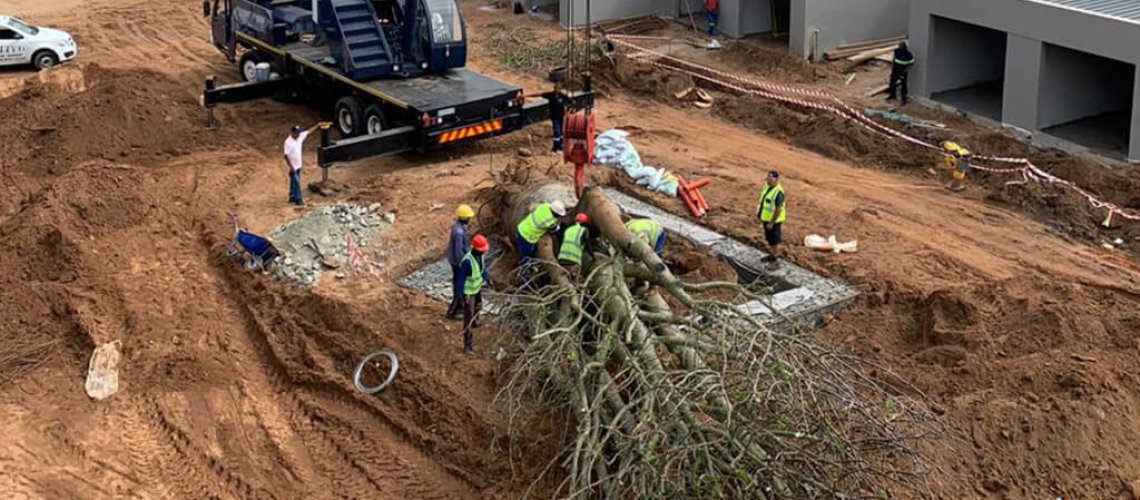The largest tree to have ever been planted in the greater Ballito area has just made Lush, Elaleni its new home. As part of greater Elaleni, Lush continues its commitment to the estate’s strong conservation ethos. The landscaping has been carefully curated to ensure that it is sustainable, promotes indigenous planting and helps existing ecosystems to proliferate while aiding in establishing new ecosystems through the introduction of new trees and plants with an 80% indigenous and 20% non-invasive exotic mix. The new addition to Lush, Adansonia Digitata or African Baobab, was found growing in amongst a macadamia orchard and desperately needed to be re-homed in order to survive.
Designed by landscape architect Lucas Uys, of Uys & White Landscape Artists, in partnership with Hennie Wilkinson of River Project, the vision of the Lush landscape was to include this iconic African tree as a central point and anchor, however sourcing and transplanting these majestic giants is a challenge as Wilkinson explains, “We managed to source the Adansonia Digitata after a search of a few months but it is not simply a case of taking it out the ground and moving it to where it’s needed; it’s Illegal to transplant naturally occurring Baobabs from their natural habitat. Luckily, we came across a tree that was growing amongst a macadamia orchard and needed to be re-homed in order to preserve it as they don’t do well in those situations in the long term. But this particular specimen had been planted by a man and, due to that, we are allowed to transplant it so therefore sought and achieved the necessary permissions to move it to its new home at Lush.”
Transporting these trees is no mean feat and takes extensive planning and logistics to ensure the tree makes it to its destination in good health. Wilkinson was part of a team which relocated several Baobabs when the N1 highway near Musina was under construction, including a specimen which was 1000-years old. Wilkinson comments, “ Although their root structures are very resilient and can tolerate extensive damage, we still took every precaution in transporting the tree to its new home including methods to stop any fungal attack on the tree. I am passionate about these trees and want to see them thrive therefore we did this for the good of the tree first and foremost; I would never advocate the illegal transplanting of these trees,”
Although their root structures are resilient, they are not overly complex nor extensive therefore they transplant well. These mysterious giants of the tree world can also reproduce vegetatively by planting a large branch which will then root itself and grow and mature into a tree from there. Due to the Adansonia Digitata’s dislike for too much water, it is well-suited to warmer climates and fits well with the vision of greater Elaleni to uphold a strong conservation ethos which encourages thoughtful use of natural resources like water.
Uys shares, “The landscape design of Lush is an extension of Elaleni and fits well with their ethos. Although aesthetics is important, the wellbeing of the flora and fauna is equally, if not more important. The Baobab has intrigued me for most of my life, and I have been germinating them and growing them from the age of 4; I feel like these trees are truly part of who I am. The Baobab is an iconic African symbol and, in many communities, a place to gather, as the heart of a community, if you will. Due to the sheer size they grow to, these trees literally give life by creating their own ecosystem of birds, insects, reptiles and animals. Even elephants are drawn to them and eat the bark; Baobabs are an important source of fodder for wild and domestic animals in Africa and are one of the few large trees that can survive this ringbarking. This particular specimen we have sourced is about 30 years old with a height of 10 metres and a trunk circumference of 2 metres- it’s already large but they can get much bigger than this and live for thousands of years. Have you ever stood under a Baobab- it’s breathtaking!”
In order to ensure the tree thrives in its new environment, an above-soil gabion planter box will provide the platform for the tree in which layers of coarse river sand and compost are laid. “These are beautiful and resilient trees but that doesn’t mean we transplant it and hope for the best- every step will be taken to ensure its wellbeing including a special planting cocktail which will provide nutrients and allow for adequate drainage between watering events. This tree does not like to be drenched and therefore we have implemented a strict watering regime to allow enough time for it to ‘dry’ before the next one. Once it starts to sprout, we know that it is on its way to adapting to its new home and thriving. Amongst so many things that make the Baobab truly remarkable, they also transplant really well which is very unusual for such a large species.” Uys ends.

